Mobile Devices and Network Security: A Comprehensive Analysis
VerifiedAdded on 2023/04/06
|7
|1893
|181
Report
AI Summary
This report provides a comprehensive analysis of mobile device and network security, addressing the increasing challenges posed by the proliferation of network-enabled devices. It begins with an introduction highlighting the growing need for internet connectivity and the subsequent rise in security concerns. The report then delves into the operational fundamentals and networking principles, emphasizing the importance of securing data and devices. Key threats such as unsecured wireless networks, data leaks, network spoofing, phishing attacks, spyware, and malware are examined in detail, along with potential vulnerabilities associated with mobile applications and data storage. The report proposes various security measures, including secure web gateways, endpoint security, and virtual private networks (VPNs), while also advocating for government regulations and international cooperation to enhance mobile security. Weaknesses in current security practices are identified, such as a lack of user awareness and the vulnerabilities of mobile devices compared to personal computers. The report concludes by summarizing the key findings and reinforcing the need for proactive security measures by individuals, organizations, and governmental bodies to mitigate the evolving landscape of mobile network threats. The report emphasizes the importance of secure networks, VPNs, and endpoint security to protect sensitive information.
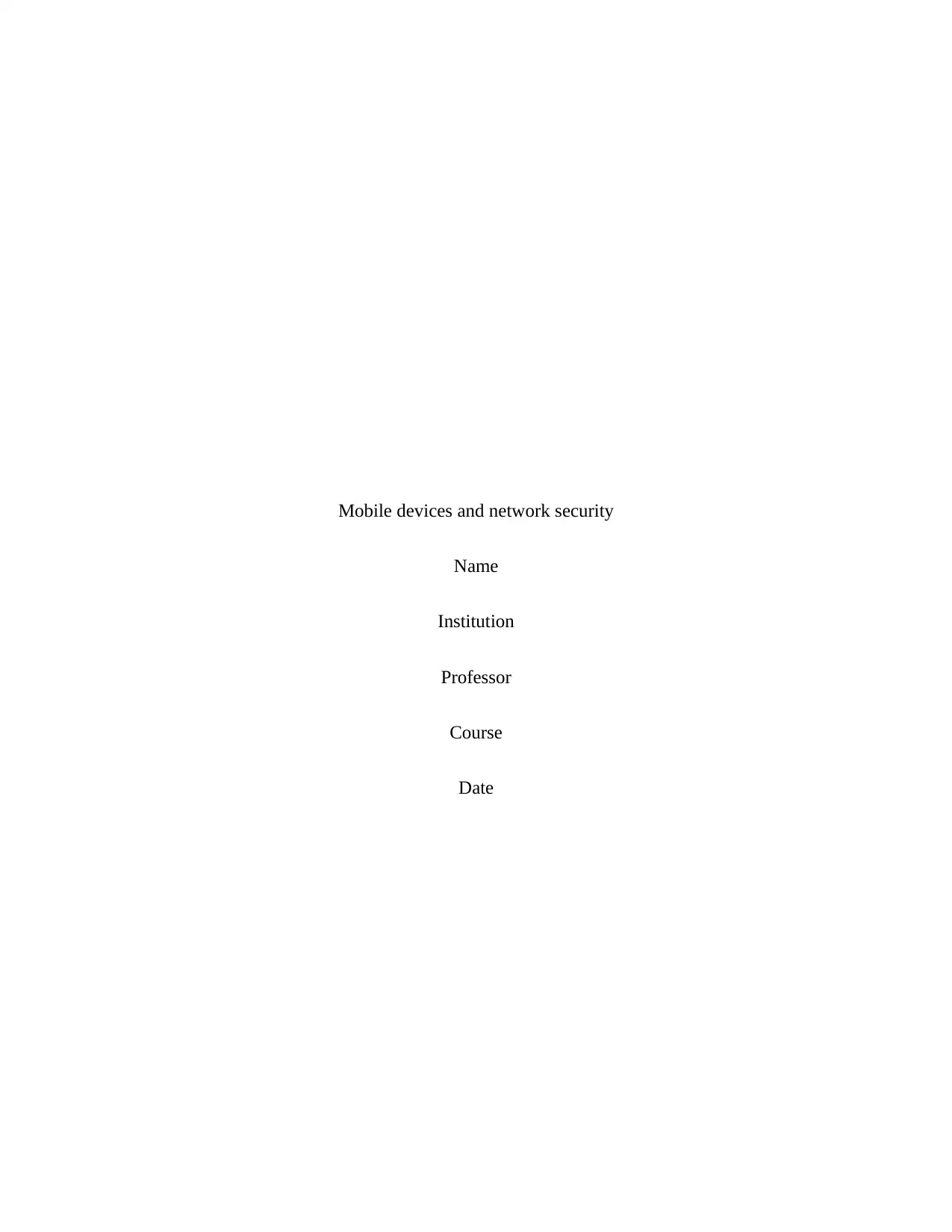
Mobile devices and network security
Name
Institution
Professor
Course
Date
Name
Institution
Professor
Course
Date
Paraphrase This Document
Need a fresh take? Get an instant paraphrase of this document with our AI Paraphraser
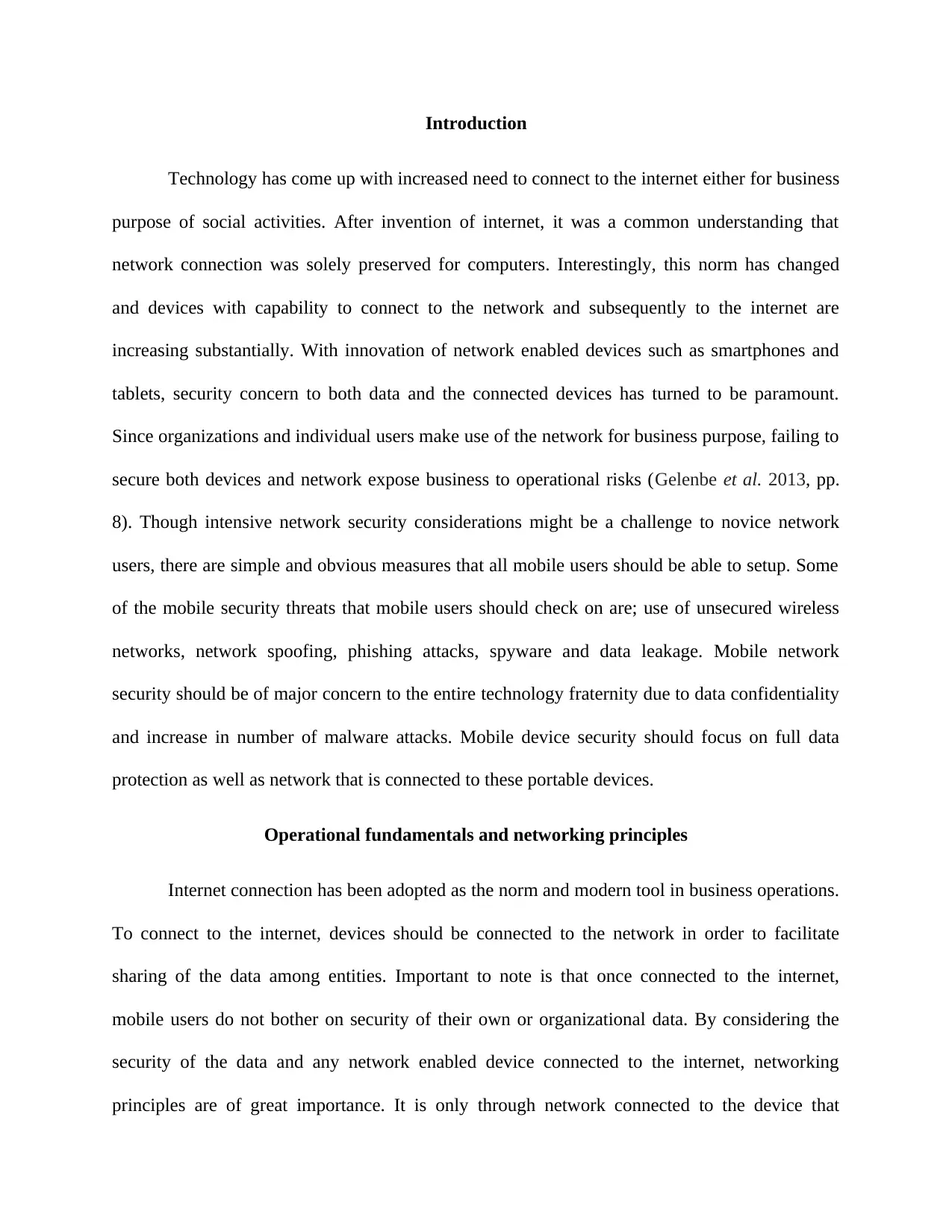
Introduction
Technology has come up with increased need to connect to the internet either for business
purpose of social activities. After invention of internet, it was a common understanding that
network connection was solely preserved for computers. Interestingly, this norm has changed
and devices with capability to connect to the network and subsequently to the internet are
increasing substantially. With innovation of network enabled devices such as smartphones and
tablets, security concern to both data and the connected devices has turned to be paramount.
Since organizations and individual users make use of the network for business purpose, failing to
secure both devices and network expose business to operational risks (Gelenbe et al. 2013, pp.
8). Though intensive network security considerations might be a challenge to novice network
users, there are simple and obvious measures that all mobile users should be able to setup. Some
of the mobile security threats that mobile users should check on are; use of unsecured wireless
networks, network spoofing, phishing attacks, spyware and data leakage. Mobile network
security should be of major concern to the entire technology fraternity due to data confidentiality
and increase in number of malware attacks. Mobile device security should focus on full data
protection as well as network that is connected to these portable devices.
Operational fundamentals and networking principles
Internet connection has been adopted as the norm and modern tool in business operations.
To connect to the internet, devices should be connected to the network in order to facilitate
sharing of the data among entities. Important to note is that once connected to the internet,
mobile users do not bother on security of their own or organizational data. By considering the
security of the data and any network enabled device connected to the internet, networking
principles are of great importance. It is only through network connected to the device that
Technology has come up with increased need to connect to the internet either for business
purpose of social activities. After invention of internet, it was a common understanding that
network connection was solely preserved for computers. Interestingly, this norm has changed
and devices with capability to connect to the network and subsequently to the internet are
increasing substantially. With innovation of network enabled devices such as smartphones and
tablets, security concern to both data and the connected devices has turned to be paramount.
Since organizations and individual users make use of the network for business purpose, failing to
secure both devices and network expose business to operational risks (Gelenbe et al. 2013, pp.
8). Though intensive network security considerations might be a challenge to novice network
users, there are simple and obvious measures that all mobile users should be able to setup. Some
of the mobile security threats that mobile users should check on are; use of unsecured wireless
networks, network spoofing, phishing attacks, spyware and data leakage. Mobile network
security should be of major concern to the entire technology fraternity due to data confidentiality
and increase in number of malware attacks. Mobile device security should focus on full data
protection as well as network that is connected to these portable devices.
Operational fundamentals and networking principles
Internet connection has been adopted as the norm and modern tool in business operations.
To connect to the internet, devices should be connected to the network in order to facilitate
sharing of the data among entities. Important to note is that once connected to the internet,
mobile users do not bother on security of their own or organizational data. By considering the
security of the data and any network enabled device connected to the internet, networking
principles are of great importance. It is only through network connected to the device that
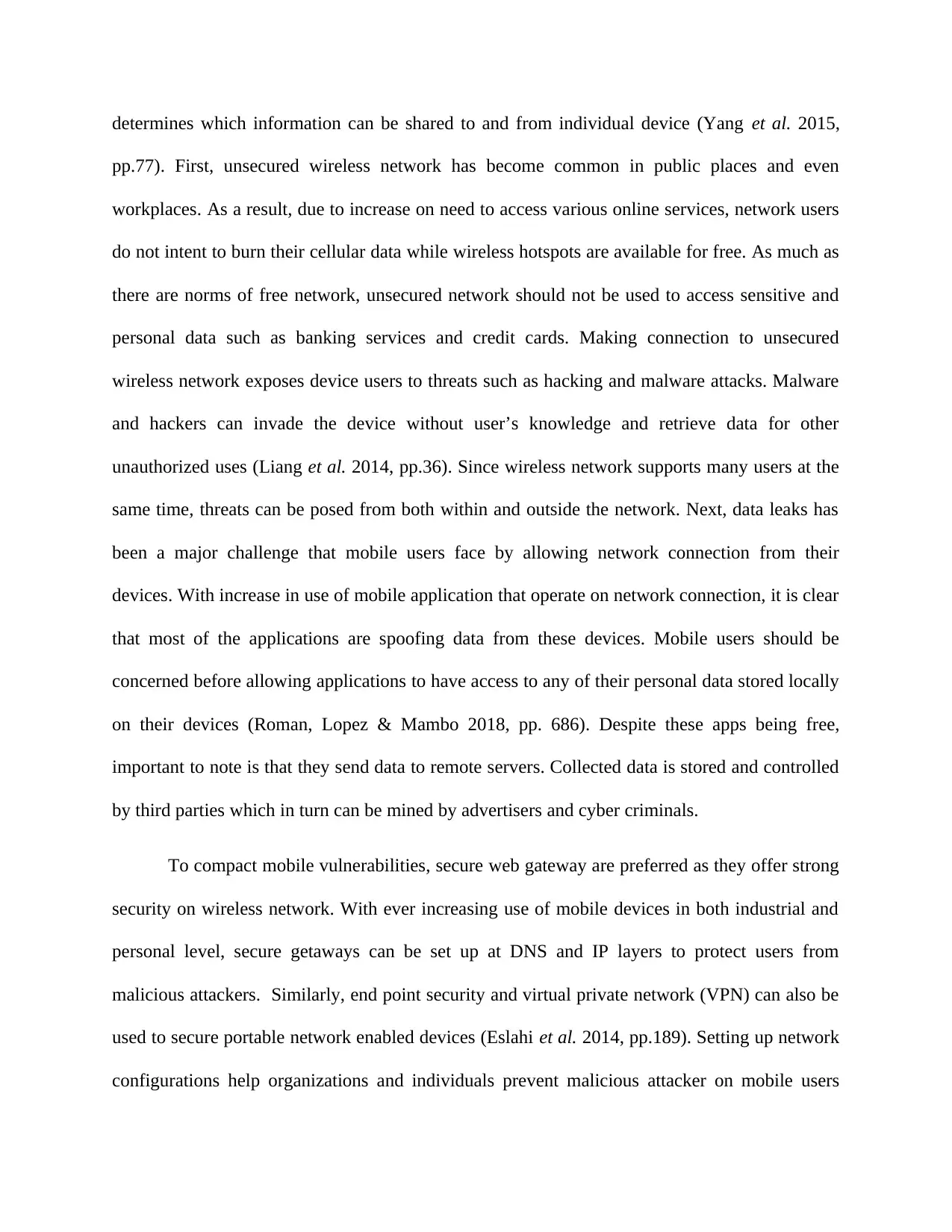
determines which information can be shared to and from individual device (Yang et al. 2015,
pp.77). First, unsecured wireless network has become common in public places and even
workplaces. As a result, due to increase on need to access various online services, network users
do not intent to burn their cellular data while wireless hotspots are available for free. As much as
there are norms of free network, unsecured network should not be used to access sensitive and
personal data such as banking services and credit cards. Making connection to unsecured
wireless network exposes device users to threats such as hacking and malware attacks. Malware
and hackers can invade the device without user’s knowledge and retrieve data for other
unauthorized uses (Liang et al. 2014, pp.36). Since wireless network supports many users at the
same time, threats can be posed from both within and outside the network. Next, data leaks has
been a major challenge that mobile users face by allowing network connection from their
devices. With increase in use of mobile application that operate on network connection, it is clear
that most of the applications are spoofing data from these devices. Mobile users should be
concerned before allowing applications to have access to any of their personal data stored locally
on their devices (Roman, Lopez & Mambo 2018, pp. 686). Despite these apps being free,
important to note is that they send data to remote servers. Collected data is stored and controlled
by third parties which in turn can be mined by advertisers and cyber criminals.
To compact mobile vulnerabilities, secure web gateway are preferred as they offer strong
security on wireless network. With ever increasing use of mobile devices in both industrial and
personal level, secure getaways can be set up at DNS and IP layers to protect users from
malicious attackers. Similarly, end point security and virtual private network (VPN) can also be
used to secure portable network enabled devices (Eslahi et al. 2014, pp.189). Setting up network
configurations help organizations and individuals prevent malicious attacker on mobile users
pp.77). First, unsecured wireless network has become common in public places and even
workplaces. As a result, due to increase on need to access various online services, network users
do not intent to burn their cellular data while wireless hotspots are available for free. As much as
there are norms of free network, unsecured network should not be used to access sensitive and
personal data such as banking services and credit cards. Making connection to unsecured
wireless network exposes device users to threats such as hacking and malware attacks. Malware
and hackers can invade the device without user’s knowledge and retrieve data for other
unauthorized uses (Liang et al. 2014, pp.36). Since wireless network supports many users at the
same time, threats can be posed from both within and outside the network. Next, data leaks has
been a major challenge that mobile users face by allowing network connection from their
devices. With increase in use of mobile application that operate on network connection, it is clear
that most of the applications are spoofing data from these devices. Mobile users should be
concerned before allowing applications to have access to any of their personal data stored locally
on their devices (Roman, Lopez & Mambo 2018, pp. 686). Despite these apps being free,
important to note is that they send data to remote servers. Collected data is stored and controlled
by third parties which in turn can be mined by advertisers and cyber criminals.
To compact mobile vulnerabilities, secure web gateway are preferred as they offer strong
security on wireless network. With ever increasing use of mobile devices in both industrial and
personal level, secure getaways can be set up at DNS and IP layers to protect users from
malicious attackers. Similarly, end point security and virtual private network (VPN) can also be
used to secure portable network enabled devices (Eslahi et al. 2014, pp.189). Setting up network
configurations help organizations and individuals prevent malicious attacker on mobile users
⊘ This is a preview!⊘
Do you want full access?
Subscribe today to unlock all pages.

Trusted by 1+ million students worldwide
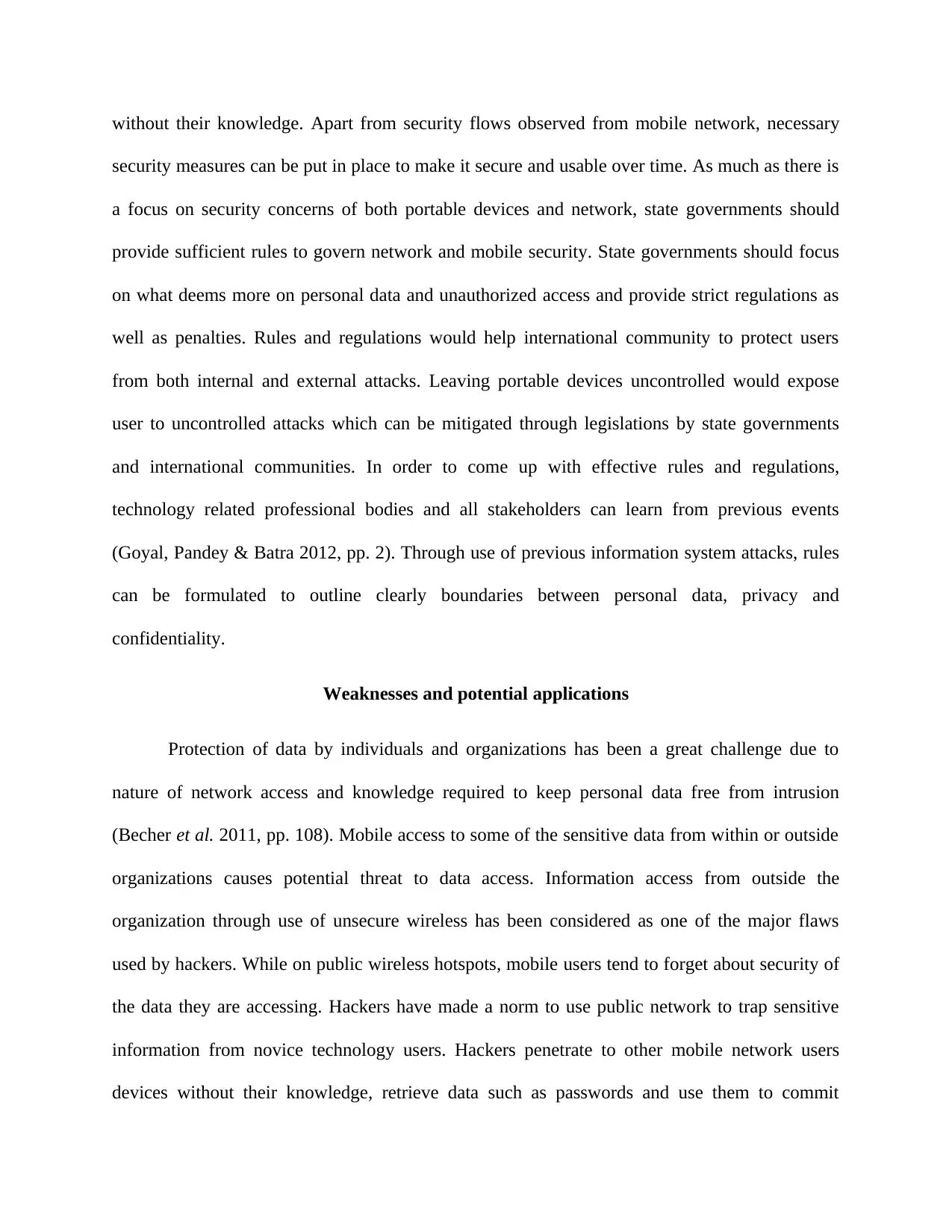
without their knowledge. Apart from security flows observed from mobile network, necessary
security measures can be put in place to make it secure and usable over time. As much as there is
a focus on security concerns of both portable devices and network, state governments should
provide sufficient rules to govern network and mobile security. State governments should focus
on what deems more on personal data and unauthorized access and provide strict regulations as
well as penalties. Rules and regulations would help international community to protect users
from both internal and external attacks. Leaving portable devices uncontrolled would expose
user to uncontrolled attacks which can be mitigated through legislations by state governments
and international communities. In order to come up with effective rules and regulations,
technology related professional bodies and all stakeholders can learn from previous events
(Goyal, Pandey & Batra 2012, pp. 2). Through use of previous information system attacks, rules
can be formulated to outline clearly boundaries between personal data, privacy and
confidentiality.
Weaknesses and potential applications
Protection of data by individuals and organizations has been a great challenge due to
nature of network access and knowledge required to keep personal data free from intrusion
(Becher et al. 2011, pp. 108). Mobile access to some of the sensitive data from within or outside
organizations causes potential threat to data access. Information access from outside the
organization through use of unsecure wireless has been considered as one of the major flaws
used by hackers. While on public wireless hotspots, mobile users tend to forget about security of
the data they are accessing. Hackers have made a norm to use public network to trap sensitive
information from novice technology users. Hackers penetrate to other mobile network users
devices without their knowledge, retrieve data such as passwords and use them to commit
security measures can be put in place to make it secure and usable over time. As much as there is
a focus on security concerns of both portable devices and network, state governments should
provide sufficient rules to govern network and mobile security. State governments should focus
on what deems more on personal data and unauthorized access and provide strict regulations as
well as penalties. Rules and regulations would help international community to protect users
from both internal and external attacks. Leaving portable devices uncontrolled would expose
user to uncontrolled attacks which can be mitigated through legislations by state governments
and international communities. In order to come up with effective rules and regulations,
technology related professional bodies and all stakeholders can learn from previous events
(Goyal, Pandey & Batra 2012, pp. 2). Through use of previous information system attacks, rules
can be formulated to outline clearly boundaries between personal data, privacy and
confidentiality.
Weaknesses and potential applications
Protection of data by individuals and organizations has been a great challenge due to
nature of network access and knowledge required to keep personal data free from intrusion
(Becher et al. 2011, pp. 108). Mobile access to some of the sensitive data from within or outside
organizations causes potential threat to data access. Information access from outside the
organization through use of unsecure wireless has been considered as one of the major flaws
used by hackers. While on public wireless hotspots, mobile users tend to forget about security of
the data they are accessing. Hackers have made a norm to use public network to trap sensitive
information from novice technology users. Hackers penetrate to other mobile network users
devices without their knowledge, retrieve data such as passwords and use them to commit
Paraphrase This Document
Need a fresh take? Get an instant paraphrase of this document with our AI Paraphraser
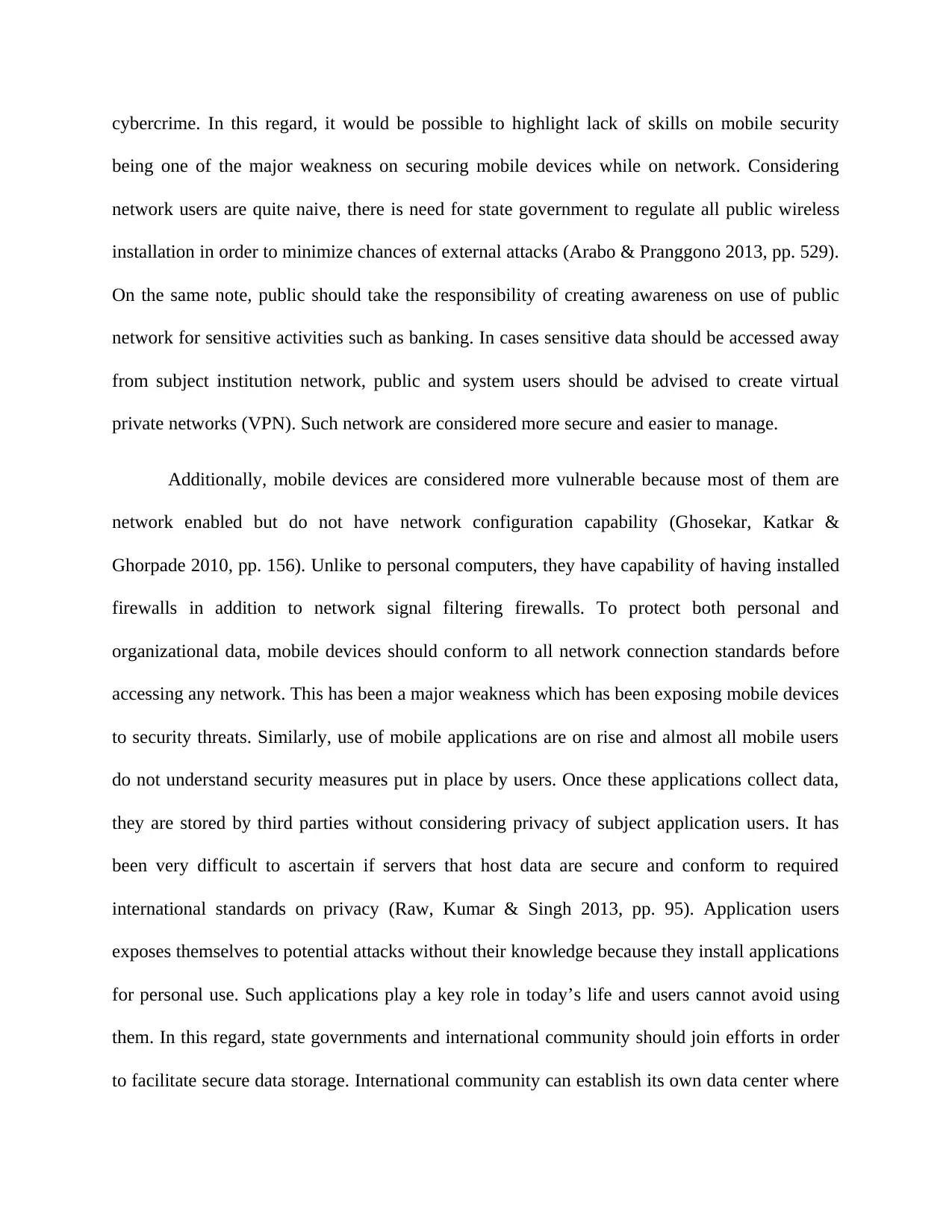
cybercrime. In this regard, it would be possible to highlight lack of skills on mobile security
being one of the major weakness on securing mobile devices while on network. Considering
network users are quite naive, there is need for state government to regulate all public wireless
installation in order to minimize chances of external attacks (Arabo & Pranggono 2013, pp. 529).
On the same note, public should take the responsibility of creating awareness on use of public
network for sensitive activities such as banking. In cases sensitive data should be accessed away
from subject institution network, public and system users should be advised to create virtual
private networks (VPN). Such network are considered more secure and easier to manage.
Additionally, mobile devices are considered more vulnerable because most of them are
network enabled but do not have network configuration capability (Ghosekar, Katkar &
Ghorpade 2010, pp. 156). Unlike to personal computers, they have capability of having installed
firewalls in addition to network signal filtering firewalls. To protect both personal and
organizational data, mobile devices should conform to all network connection standards before
accessing any network. This has been a major weakness which has been exposing mobile devices
to security threats. Similarly, use of mobile applications are on rise and almost all mobile users
do not understand security measures put in place by users. Once these applications collect data,
they are stored by third parties without considering privacy of subject application users. It has
been very difficult to ascertain if servers that host data are secure and conform to required
international standards on privacy (Raw, Kumar & Singh 2013, pp. 95). Application users
exposes themselves to potential attacks without their knowledge because they install applications
for personal use. Such applications play a key role in today’s life and users cannot avoid using
them. In this regard, state governments and international community should join efforts in order
to facilitate secure data storage. International community can establish its own data center where
being one of the major weakness on securing mobile devices while on network. Considering
network users are quite naive, there is need for state government to regulate all public wireless
installation in order to minimize chances of external attacks (Arabo & Pranggono 2013, pp. 529).
On the same note, public should take the responsibility of creating awareness on use of public
network for sensitive activities such as banking. In cases sensitive data should be accessed away
from subject institution network, public and system users should be advised to create virtual
private networks (VPN). Such network are considered more secure and easier to manage.
Additionally, mobile devices are considered more vulnerable because most of them are
network enabled but do not have network configuration capability (Ghosekar, Katkar &
Ghorpade 2010, pp. 156). Unlike to personal computers, they have capability of having installed
firewalls in addition to network signal filtering firewalls. To protect both personal and
organizational data, mobile devices should conform to all network connection standards before
accessing any network. This has been a major weakness which has been exposing mobile devices
to security threats. Similarly, use of mobile applications are on rise and almost all mobile users
do not understand security measures put in place by users. Once these applications collect data,
they are stored by third parties without considering privacy of subject application users. It has
been very difficult to ascertain if servers that host data are secure and conform to required
international standards on privacy (Raw, Kumar & Singh 2013, pp. 95). Application users
exposes themselves to potential attacks without their knowledge because they install applications
for personal use. Such applications play a key role in today’s life and users cannot avoid using
them. In this regard, state governments and international community should join efforts in order
to facilitate secure data storage. International community can establish its own data center where
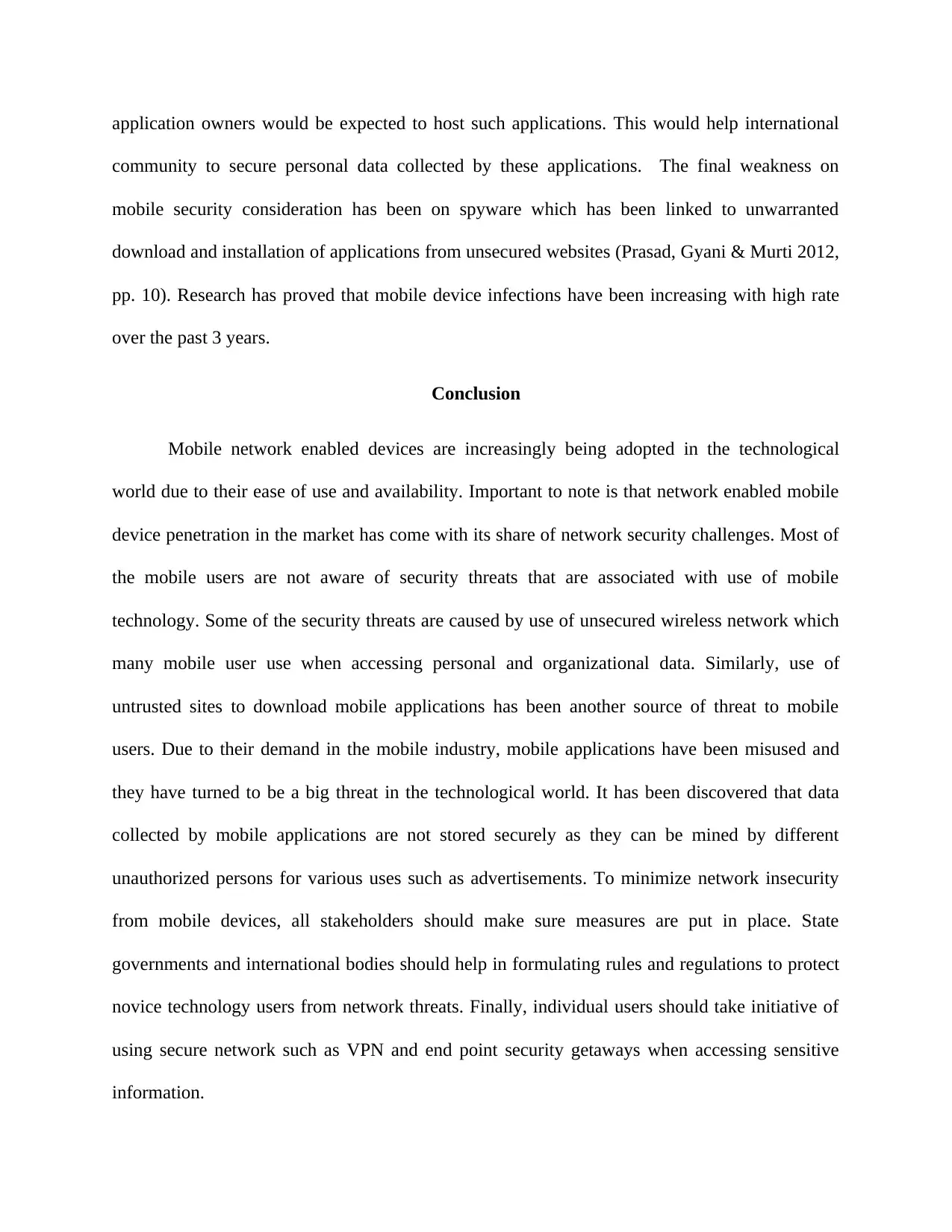
application owners would be expected to host such applications. This would help international
community to secure personal data collected by these applications. The final weakness on
mobile security consideration has been on spyware which has been linked to unwarranted
download and installation of applications from unsecured websites (Prasad, Gyani & Murti 2012,
pp. 10). Research has proved that mobile device infections have been increasing with high rate
over the past 3 years.
Conclusion
Mobile network enabled devices are increasingly being adopted in the technological
world due to their ease of use and availability. Important to note is that network enabled mobile
device penetration in the market has come with its share of network security challenges. Most of
the mobile users are not aware of security threats that are associated with use of mobile
technology. Some of the security threats are caused by use of unsecured wireless network which
many mobile user use when accessing personal and organizational data. Similarly, use of
untrusted sites to download mobile applications has been another source of threat to mobile
users. Due to their demand in the mobile industry, mobile applications have been misused and
they have turned to be a big threat in the technological world. It has been discovered that data
collected by mobile applications are not stored securely as they can be mined by different
unauthorized persons for various uses such as advertisements. To minimize network insecurity
from mobile devices, all stakeholders should make sure measures are put in place. State
governments and international bodies should help in formulating rules and regulations to protect
novice technology users from network threats. Finally, individual users should take initiative of
using secure network such as VPN and end point security getaways when accessing sensitive
information.
community to secure personal data collected by these applications. The final weakness on
mobile security consideration has been on spyware which has been linked to unwarranted
download and installation of applications from unsecured websites (Prasad, Gyani & Murti 2012,
pp. 10). Research has proved that mobile device infections have been increasing with high rate
over the past 3 years.
Conclusion
Mobile network enabled devices are increasingly being adopted in the technological
world due to their ease of use and availability. Important to note is that network enabled mobile
device penetration in the market has come with its share of network security challenges. Most of
the mobile users are not aware of security threats that are associated with use of mobile
technology. Some of the security threats are caused by use of unsecured wireless network which
many mobile user use when accessing personal and organizational data. Similarly, use of
untrusted sites to download mobile applications has been another source of threat to mobile
users. Due to their demand in the mobile industry, mobile applications have been misused and
they have turned to be a big threat in the technological world. It has been discovered that data
collected by mobile applications are not stored securely as they can be mined by different
unauthorized persons for various uses such as advertisements. To minimize network insecurity
from mobile devices, all stakeholders should make sure measures are put in place. State
governments and international bodies should help in formulating rules and regulations to protect
novice technology users from network threats. Finally, individual users should take initiative of
using secure network such as VPN and end point security getaways when accessing sensitive
information.
⊘ This is a preview!⊘
Do you want full access?
Subscribe today to unlock all pages.

Trusted by 1+ million students worldwide
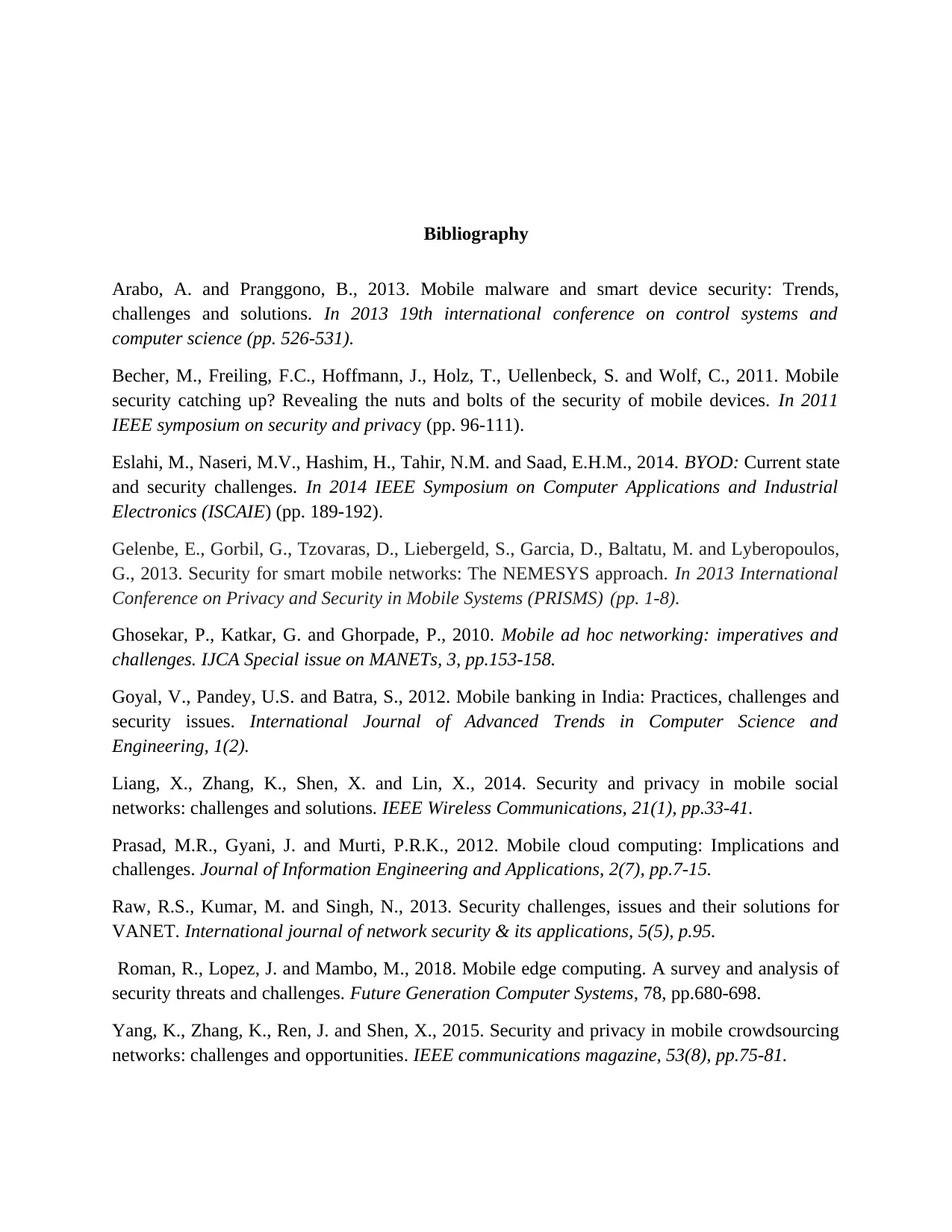
Bibliography
Arabo, A. and Pranggono, B., 2013. Mobile malware and smart device security: Trends,
challenges and solutions. In 2013 19th international conference on control systems and
computer science (pp. 526-531).
Becher, M., Freiling, F.C., Hoffmann, J., Holz, T., Uellenbeck, S. and Wolf, C., 2011. Mobile
security catching up? Revealing the nuts and bolts of the security of mobile devices. In 2011
IEEE symposium on security and privacy (pp. 96-111).
Eslahi, M., Naseri, M.V., Hashim, H., Tahir, N.M. and Saad, E.H.M., 2014. BYOD: Current state
and security challenges. In 2014 IEEE Symposium on Computer Applications and Industrial
Electronics (ISCAIE) (pp. 189-192).
Gelenbe, E., Gorbil, G., Tzovaras, D., Liebergeld, S., Garcia, D., Baltatu, M. and Lyberopoulos,
G., 2013. Security for smart mobile networks: The NEMESYS approach. In 2013 International
Conference on Privacy and Security in Mobile Systems (PRISMS) (pp. 1-8).
Ghosekar, P., Katkar, G. and Ghorpade, P., 2010. Mobile ad hoc networking: imperatives and
challenges. IJCA Special issue on MANETs, 3, pp.153-158.
Goyal, V., Pandey, U.S. and Batra, S., 2012. Mobile banking in India: Practices, challenges and
security issues. International Journal of Advanced Trends in Computer Science and
Engineering, 1(2).
Liang, X., Zhang, K., Shen, X. and Lin, X., 2014. Security and privacy in mobile social
networks: challenges and solutions. IEEE Wireless Communications, 21(1), pp.33-41.
Prasad, M.R., Gyani, J. and Murti, P.R.K., 2012. Mobile cloud computing: Implications and
challenges. Journal of Information Engineering and Applications, 2(7), pp.7-15.
Raw, R.S., Kumar, M. and Singh, N., 2013. Security challenges, issues and their solutions for
VANET. International journal of network security & its applications, 5(5), p.95.
Roman, R., Lopez, J. and Mambo, M., 2018. Mobile edge computing. A survey and analysis of
security threats and challenges. Future Generation Computer Systems, 78, pp.680-698.
Yang, K., Zhang, K., Ren, J. and Shen, X., 2015. Security and privacy in mobile crowdsourcing
networks: challenges and opportunities. IEEE communications magazine, 53(8), pp.75-81.
Arabo, A. and Pranggono, B., 2013. Mobile malware and smart device security: Trends,
challenges and solutions. In 2013 19th international conference on control systems and
computer science (pp. 526-531).
Becher, M., Freiling, F.C., Hoffmann, J., Holz, T., Uellenbeck, S. and Wolf, C., 2011. Mobile
security catching up? Revealing the nuts and bolts of the security of mobile devices. In 2011
IEEE symposium on security and privacy (pp. 96-111).
Eslahi, M., Naseri, M.V., Hashim, H., Tahir, N.M. and Saad, E.H.M., 2014. BYOD: Current state
and security challenges. In 2014 IEEE Symposium on Computer Applications and Industrial
Electronics (ISCAIE) (pp. 189-192).
Gelenbe, E., Gorbil, G., Tzovaras, D., Liebergeld, S., Garcia, D., Baltatu, M. and Lyberopoulos,
G., 2013. Security for smart mobile networks: The NEMESYS approach. In 2013 International
Conference on Privacy and Security in Mobile Systems (PRISMS) (pp. 1-8).
Ghosekar, P., Katkar, G. and Ghorpade, P., 2010. Mobile ad hoc networking: imperatives and
challenges. IJCA Special issue on MANETs, 3, pp.153-158.
Goyal, V., Pandey, U.S. and Batra, S., 2012. Mobile banking in India: Practices, challenges and
security issues. International Journal of Advanced Trends in Computer Science and
Engineering, 1(2).
Liang, X., Zhang, K., Shen, X. and Lin, X., 2014. Security and privacy in mobile social
networks: challenges and solutions. IEEE Wireless Communications, 21(1), pp.33-41.
Prasad, M.R., Gyani, J. and Murti, P.R.K., 2012. Mobile cloud computing: Implications and
challenges. Journal of Information Engineering and Applications, 2(7), pp.7-15.
Raw, R.S., Kumar, M. and Singh, N., 2013. Security challenges, issues and their solutions for
VANET. International journal of network security & its applications, 5(5), p.95.
Roman, R., Lopez, J. and Mambo, M., 2018. Mobile edge computing. A survey and analysis of
security threats and challenges. Future Generation Computer Systems, 78, pp.680-698.
Yang, K., Zhang, K., Ren, J. and Shen, X., 2015. Security and privacy in mobile crowdsourcing
networks: challenges and opportunities. IEEE communications magazine, 53(8), pp.75-81.
1 out of 7
Related Documents
Your All-in-One AI-Powered Toolkit for Academic Success.
+13062052269
info@desklib.com
Available 24*7 on WhatsApp / Email
![[object Object]](/_next/static/media/star-bottom.7253800d.svg)
Unlock your academic potential
Copyright © 2020–2025 A2Z Services. All Rights Reserved. Developed and managed by ZUCOL.




